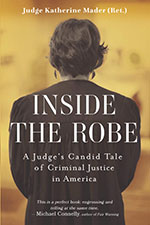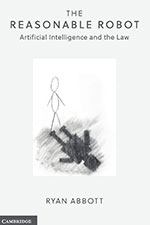 VERDICT: It’s a Keeper
VERDICT: It’s a Keeper
Inside the Robe: A Judge’s Candid Tale of Criminal Justice in America
By Judge Katherine Mader (Ret.) (Brooklyn, NY: Antenna Books, 2020). 370 pgs. $14.99. Order, www.amazon.com.
Reviewed by Irwin Kass
The author, Judge Katherine Mader (retired), navigates the reader on a voyage through a large city’s criminal justice system. She invites readers to take this trip in the preface, saying: “Come with me behind the scenes of my courthouse (Los Angeles, CA) for a calendar year (2016). You will see the liveliness, camaraderie, as well as the daily frustrations among my staff, prosecutors, and defense attorneys, the highs and lows of jury trials and my friendships and relationships with fellow judges.” Readers will feel as if they’re sitting up front in Mader’s courtroom as she referees the daily battles between the state and the accused. Her candor is refreshing, and the experience will be well worth the time.
Mader wore a judicial robe for approximately 20 years. Before becoming a judge, she was a criminal defense lawyer and later a prosecutor. She was also the first inspector general of the Los Angeles Police Department, with the responsibility to investigate police misconduct. Her performance in these jobs earned her a “well qualified” rating when running for election as a judge. She opens the book with one of her first court appearances, at which she was admonished by a judge for complaining that her client’s prison sentence was not “fair.” He told her not to use that word in court because its meaning depends on one’s point of view. His advice helped guide her career as a lawyer and judge.
Mader’s book is structured as a diary, from January through December 2016. This approach is helpful for following the variety, complexity, and progress of the many criminal cases flowing into and out of her courtroom. Mader often slows the pace to explain in layperson’s terms what is going on and the rationale for her decisions. We learn her thought processes on numerous issues including criminal charges and sentences, juror intimidation, gang violence, police misconduct, and judicial discipline.
Want to Review a Book?
Please request a book and writing guidelines from Wisconsin Lawyer managing editor Karlé Lester, at klester@wisbar.org or (608) 250-6127. Reviewers may keep the book reviewed. Reviews of about 500 words are due within 45 days of receiving the book. Reviews are published, space permitting, in the order received and may be edited for length and clarity.
Mader’s varied docket included murder, manslaughter, armed robbery, bank hold-up, drug, driving while intoxicated, repeat sexual offender, “three strikes” crime, and domestic violence cases. Many cases were settled by plea bargain but some went to trial and a few were dismissed. She shares interesting anecdotes from these and other matters about judges, plea negotiations, sentencing, expert and lay witnesses, juries, victims, defendants, and lawyers.
The reader will appreciate her struggle to achieve in every case a result that is, as she says, “reasonable, equitable and just.” She approached each case with a determination, as she emphasizes, to “follow the law.” However, as she explains, reaching this goal leads to “wildly different results from judge to judge.” Many factors, she explains, including “background, schooling, life experiences, and cultural as well as political preferences” influence judges’ decisions, even though setting aside such biases is a job requirement. When pertinent, she discusses the effects on cases of race, gender, nationality, income, or education.
Striving to be fair often put Mader at odds with prosecutors, who might have thought she was being too lenient. She also was aware of the risks of being too harsh, lest she draw the ire of the public defender office, whose lawyers frequently were in her courtroom because most defendants cannot afford a private lawyer.
Disqualification of a judge on any case is a remedy available to both sides. In particular, the implied and expressed threat of the district attorney ordering all prosecutors to disqualify her on every case was like a storm cloud in the distance. If carried out, she would have no work to do and ultimately lose her job as a criminal law judge. She usually found the delicate balance between being too lenient and too harsh.
Mader leaves readers with the assurance that the system, though flawed and sometimes arbitrary, works. Fortunately, our society still has the capacity to hold people criminally accountable, showing firmness when needed and mercy when called for under the facts of each case.
Irwin Kass, Chicago-Kent 1976, is a retired Madison lawyer.
 VERDICT: It’s a Keeper
VERDICT: It’s a Keeper
The Reasonable Robot: Artificial Intelligence and the Law
By Ryan Abbot (New York, NY: Cambridge Univ. Press, 2020). 166 pgs. $29.99. Order, www.cambridge.org.
Reviewed by Douglas Bauman
The premise of this book is that the law should adopt a principle of legal neutrality toward artificial intelligence (AI). In support of that argument, author Ryan Abbott explains what AI is, how the law currently treats it, and the unintended and undesirable consequences that arise from that treatment. The result is an illuminating tour of the law viewed through the lens of AI, considering not only where human beings are but also where we are headed.
In particular, the book examines four areas of the law: tax, tort, intellectual property, and criminal law. In each area, the law’s treatment of AI can result in outcomes that are contrary to the law’s purposes and goals.
For instance, tax law currently encourages automation but has the effect of reducing tax revenue. Meanwhile, the purpose of tort law is to deter unsafe conduct, but because AI would be subject to strict liability, the law discourages the use of AI, even if it would be safer than human actors. Similarly, intellectual property law encourages socially valuable activities, but the law’s current insistence on a human creator will inhibit development of AI-assisted inventions. Finally, just as corporations can currently be held criminally liable, we may see criminal acts that result from autonomous AI, without any human party who can be held responsible.
In each of those areas, the principle of AI legal neutrality would address the disparity in the treatment afforded to humans and AI. The principle does not involve granting legal personhood to AI, and it does not mean that humans and AI need to be treated exactly the same. Rather, it involves taking the unintended consequences into account.
The book devotes one chapter apiece to tax, tort, and criminal law; intellectual property law gets two chapters (one focused on the present and one looking to the future). The additional time spent on intellectual property law is unsurprising, given the author’s background. Abbott is a patent attorney, in addition to being a physician and a professor of law and of medicine, and in 2019, he led an effort to file patents in several jurisdictions for inventions created autonomously by AI. He has also published several law review articles about AI over the last few years (which he lists in an appendix), so clearly he has spent a lot of time thinking about the issue.
I found the book’s language to be clear and easy to read, while its subject matter was stimulating and thought provoking. The book itself is relatively short, which necessarily means that it provides only a survey of the area. It will not provide a reader with a deep dive into the law’s treatment of AI, but it provides an excellent starting point for what will certainly prove to be an important area to consider.
Douglas Bauman, U.W. 1998, is a court commissioner for the Marathon County Circuit Court.
 VERDICT: It’s a Keeper
VERDICT: It’s a Keeper
Retirement by Design: A Guided Workbook for Creating a Happy and Purposeful Future
By Ida O. Abbott (Berkeley, CA: Ulysses Press, 2020). 262 pgs. $19.95. Order, www.amazon.com.
Reviewed by David Kowalski
Retirement by Design is described as a workbook to prepare for retirement, and the description fits. Each chapter provides a theme; a short explanation; numerous questions requiring the reader to consider, in depth, retirement goals; and realistic means of achieving the goals. Unlike many retirement guides, in this one the author does not dictate a specific plan or dreaded acronym-based tool guaranteeing successful retired years. Instead the reader must make that plan. The book takes readers from the early stages, contemplating reasons and expectations for retirement, through various forms of transition from daily work, to ultimately the reality of filling a day and a lifetime with other activities.
For example, in the chapter “Starting Your Transition Into Retirement,” the questions require consideration of timing, extraction from current employment or partnership, succession planning, client transition, potential negative reactions from partners, and so on. In the chapter “Impact on Relationships,” readers must consider their family’s reaction and goals, plans to remain in touch with friends, colleagues, and family, and plans to make new connections. Elsewhere, readers are asked to create a potential daily agenda to understand how to fill time without 8-10 hours’ work or list specific plans for continued education, travel, a potential new business venture, or perhaps just relaxation and family time. In each situation, if the reader answers thoughtful, precise questions, a full and feasible retirement plan should come into focus.
This is not a book on retirement financial planning nor does it claim to be. Of course, sections of the book do require consideration of assets, budget, and income post-retirement. However, the author notes correctly that there is more to retirement than having sufficient funds to cease daily work. The main thrust of the book requires serious thought about which post-retirement lifestyle would bring happiness, fulfillment, and security. Mentally and physically stimulating activities, social and family connections, health concerns, and potentially some form of continued work all may play a role. A full retirement future likely will come into greater focus for readers who engage with the concepts the book proposes.
As a small-firm owner with hopes to retire in some fashion sooner rather than later, I found this book extraordinary. This book will force readers to think about what they really want their retirement to be and may lead to some uncomfortable discussions. But such planning is necessary to provide the best chance of setting realistic goals and actually fulfilling them.
After reading the book, I changed some expectations and found answers to some lingering concerns, simply by being forced to write down actual plans before moving on. I enjoyed going through it and having these discussions. I highly recommend this book for those with an eye toward retirement.
David S. Kowalski, Marquette 2006, operates Kowalski Family Law LLC, Madison.
